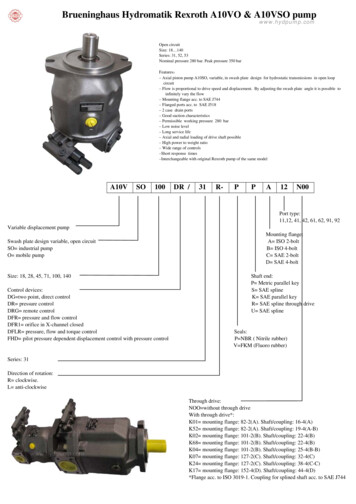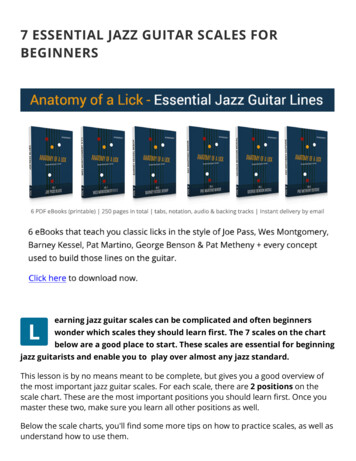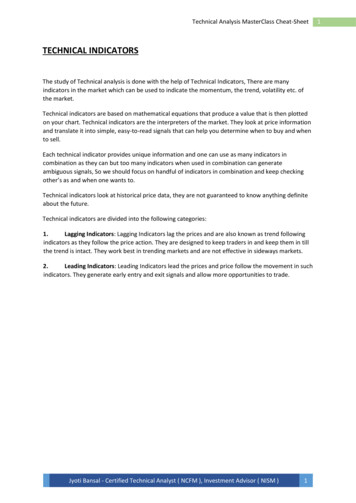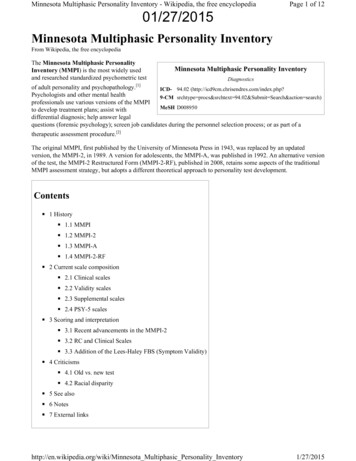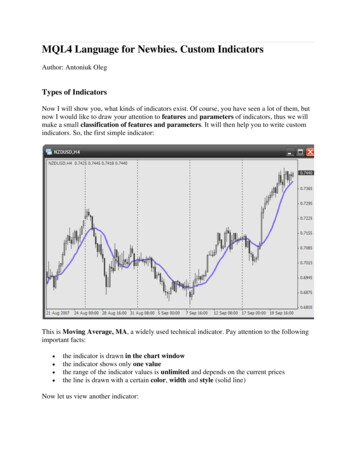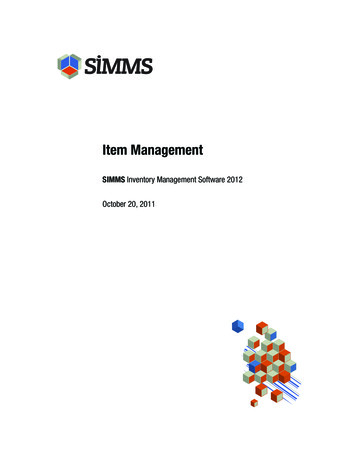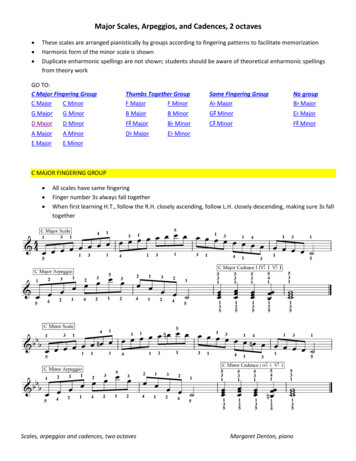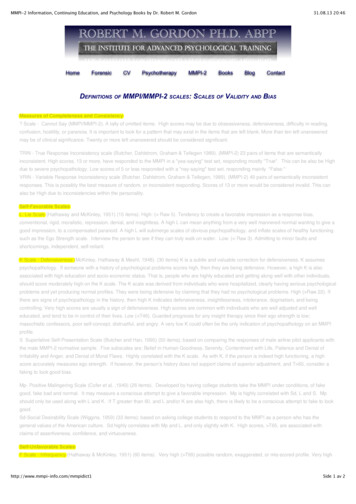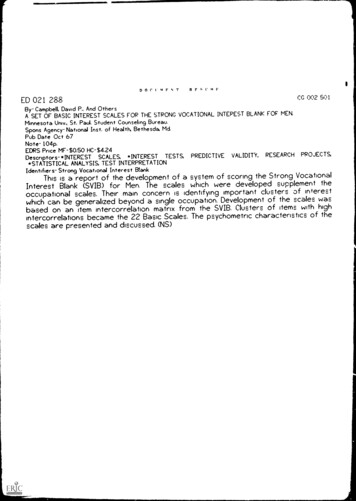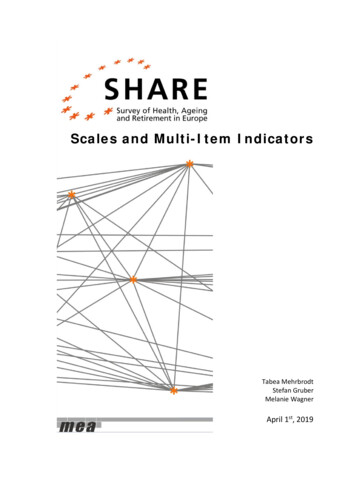
Transcription
Scales and Multi-Item IndicatorsTabea MehrbrodtStefan GruberMelanie WagnerApril 1st, 2019
Table of ContentsI.Mental health measures . 31.EURO-D . 32.CASP-12. 53.Three-Item Loneliness Scale . 74.Multi-Item Indicator Anxiety . 8II.Physical health measures . 91.Global Activity Limitation Index (GALI) . 92.Activities of Daily Living (ADL). 103.Instrumental Activities of Daily Living (IADL) . 114.Self-perceived Health – US Version (SPHUS) and EU Version (SPHEU) . 125.Multi-Item Indicator Pain . 136.Body Mass Index (BMI) . 147.Grip Strength (GS) . 158.Walking Speed . 169.Peak Flow . 1710. Chair Stand Test . 18III.Cognitive functioning measures . 191.Temporal orientation . 192.Numeracy . 203.10-words recall test . 214.Verbal fluency . 25IV.Occupational measures . 261.Effort-Reward Imbalance (ERI) questionnaire . 262.International Standard Classification of Occupations (ISCO) . 273.Statistical Classification of Economic Activities (NACE) . 30V.Educational measures . 331.VI.International Standard Classification of Education (ISCED) . 33Other . 361.The 10-item Big Five Inventory (BFI-10). 362.Multi-Item Indicator Residential Environment Quality . 372
About this manualThe purpose of this manual is to provide an informative overview of all scalesand item groups that are included in the questionnaire of Wave 1 to Wave 6of the Survey of Health, Age and Retirement in Europe (SHARE). The manualcovers literature based information on the definition and content of therespective scale or multi-item indicator and its operationalisation in SHARE.All scales and multi-item indicators are displayed in English according to thegeneric version of the SHARE questionnaire.I.Mental health measures1. EURO-DDefinitionThe EURO-D scale (Prince et al., 1999) was originally developed in an effort to derive acommon depression symptoms scale from various instruments on late-life depression usedin different European countries. The resulting scale consists of the following items:depression, pessimism, suicidality, guilt, sleep, interest, irritability, appetite, fatigue,concentration (on reading or entertainment), enjoyment, and tearfulness.Operationalisation in SHARESHARE provides the EURO-D variable (eurod) and the EURO-D caseness variable (eurodcat)as generated variables in the gv health module. eurod is generated from questions in themental health module (mh002 – mh017 ) as a composite index of the sixteen items. Pleasenote that information in mh005 /mh006 , mh008 /mh009 , mh011 /mh012 andmh014 /mh015 is combined when generating eurod so that the list of 16 items in table 1 isreduced to 12 final items. The maximum score a respondent can get is 12 “very depressed”and the minimum score is 0 “not depressed”.The attainment of a scale score of 4 or higher is categorized as “case of depression” and ascale score below 4 as “not depressed”. The generated variable eurodcat equals 1 if the scalescore is 4 or higher.3
Table 1: List of relevant EURO-D variables in the mental health module (mh)Waves: 1, 2, 4, 5, 6MH002Question textIn the last month, have youbeen sad or depressed?Response options*1. Yes5. NoMH003What are your hopes for thefuture?In the last month, have youfelt that you would ratherbe dead?Do you tend to blameyourself or feel guilty aboutanything?1. Any hopes mentioned2. No hopes mentioned1. Any mention of suicidal feelings orwishing to be dead2. No such feelings1. Obvious excessive guilt or selfblame2. No such feelings3. Mentions guilt or selfblame, but it is unclear if theseconstitute obvious or excessive guiltor self-blame1. Example(s) given constituteobvious excessive guilt or self-blame2. Example(s) do not constituteobvious excessive guilt orself-blame, or it remains unclear ifthese constitute obvious or excessiveguilt or self-blame1. Trouble with sleep or recent change in pattern2. No trouble sleeping1. Less interest than usualmentioned2. No mention of loss of interest3. Non-specific or uncodeableresponse1. Yes5. No1. Yes5. No1. Diminution in desire for food2. No diminution in desire for food3. Non-specific or uncodeableresponse1. Less2. More3. Neither more nor less1. Yes5. NoMH004MH005MH006(if MH005 3)So, for what do you blameyourself?MH007Have you had troublesleeping recently?MH008In the last month, what isyour interest in things?MH009(if MH008 3)MH010So, do you keep up yourinterests?Have you been irritablerecently?What has your appetitebeen like?MH011MH012(if MH011 3)So, have you been eatingmore or less than usual?MH013In the last month, have youhad too little energy to dothe thingsyou wanted to do?4
Waves: 1, 2, 4, 5, 6MH014Question textHow is yourconcentration? Forexample, can youconcentrate on atelevision programme, filmor radio programme?MH015Can you concentrate onsomething you read?Response options*1. Difficulty in concentrating onentertainment2. No such difficulty mentioned1. Difficulty in concentrating onreading2. No such difficulty mentionedMH016What have you enjoyed1. Fails to mention any enjoyabledoing recently?activity2. Mentions ANY enjoyment fromactivityMH017In the last month, have you 1. Yescried at all?5. No*Please note that in wave 5 the response options of these items differ from the other wavesand thus from the values shown in table 1 (see the wave 5 questionnaire).ReferencesPrince, M. J., Reischies, F., Beekman, A. T. F., Fuhrer, R., Jonker, C., Kivela, S. L., Lawlor, B.,Lobo A., Magnusson, H., Fichter, M. M., Van Oyen, H., Roelands, M., Skoog, I., Turrina, C. &Copeland, J. R. (1999). Development of the EURO-D scale – a European Union initiative tocompare symptoms of depression in 14 European centres. The British Journal of Psychiatry,174(4), 330-338.2. CASP-12DefinitionThe original CASP-19 scale (Hyde et al., 2003) is a theoretically grounded measure of qualityof life in older age. CASP-12 is the revised 12-item version of CASP-19. The scale is composedof four subscales, the initials of which make up the acronym: control, autonomy, selfrealization and pleasure. The 12 items which are presented as questions or statements tosurvey respondents are assessed on a four point Likert scale (“often”, “sometimes”, “rarely”,“never”). The resulting score is the sum of these 12 items, and ranges from the minimum of12 to the maximum of 48. A high score indicates high quality of life. The literature does notprovide an indication of a threshold which categorizes quality of life in “low” and “high”.Operationalisation in SHAREIn Wave 1, the CASP-12 questions are part of the drop-off (self-completion of a paper-andpencil questionnaire) leading to a higher share of missing data. In Wave 2, 3, 4, 5, and 6, theCASP-12 questions are part of the regular SHARE questionnaire. SHARE provides the CASP-12variable (casp) as a generated variable in the gv health module.5
Table 2: List of relevant CASP variables in the drop-off questionnaireWave: 1q 2aq 2bq 2cq 2dq 2eq 2fq 2gq 2hq 2iq 2jq 2kq 2lQuestion textMy age prevents me from doing the things Iwould like to.I feel that what happens to me is out of mycontrol.I felt left out of things.I can do the things that I want to do.Family responsibilities prevent me from doingwhat I want to do.Shortage of money stops me from doing thethings I want to do.I look forward to each day.I feel that my life has meaning.On balance, I look back on my life with asense of happiness.I feel full of energy these days.I feel that life is full of opportunities.I feel that the future looks good for -RealizationSelf-RealizationTable 3: List of relevant CASP variables in the activities module (ac)Waves: 2, 3, 4, 5, 3AC024AC025Question textHow often do you think your age prevents youfrom doing the things you would like to do?How often do you feel that what happens toyou is out of your control?How often do you feel left out of things?How often do you think that you can do thethings that you want to do?How often do you think that familyresponsibilities prevent you from doing whatyou want to do?How often do you think that shortage ofmoney stops you from doing the things youwant to do?How often do you look forward to each day?How often do you feel that your life hasmeaning?How often, on balance, do you look back onyour life with a sense of happiness?How often do you feel full of energy thesedays?How often do you feel that life is full ofopportunities?How often do you feel that the future looksgood for f-RealizationSelf-Realization6
ReferencesHyde, M., Wiggins, R. D., Higgs, P., & Blane, D. B. (2003). A measure of quality of life in earlyold age: the theory, development and properties of a needs satisfaction model (CASP-19).Aging & mental health, 7(3), 186-194.Von dem Knesebeck, O., Hyde, M., Higgs, P., Kupfer, A., Siegrist, J.: Quality of Life and WellBeing. In: Börsch-Supan, A., Brugiavini, A., Jürges, H., Mackenbach, J., Siegrist, J., Weber, G.(2005). Health, ageing and retirement in Europe – First results from the Survey of Health,Ageing and Retirement in Europe. Mannheim: Mannheim Research Institute for theEconomics of Aging (MEA).3. Three-Item Loneliness ScaleDefinitionThe Three-Item Loneliness Scale (Hughes et al., 2004) is a short version of the R-UCLALoneliness Scale (Russell et al., 1978). It measures indirect loneliness. The three itemscompanionship, left out, and isolated are answered on a three point Likert scale (“often”,“some of the time”, “hardly ever or never”). The minimum of the resulting score is 3 (“notlonely”) and the maximum is 9 (“very lonely”). The literature does not provide an indicationof a threshold which categorizes “lonely” and “not lonely”.Operationalisation in SHARESHARE provides the generated Loneliness Scale variable (loneliness) as part of the gv healthmodule. The variable is a sum score based on mh034 , mh035 and mh036 from themental health module that ranges between the values 3 “Not lonely” and 9 “Very lonely”.Table 4: Three-Item Loneliness ScaleWaves: 5, 6Question textMH034How much of the time do you feel you lack companionship?MH035How much of the time do you feel left out?MH036How much of the time do you feel isolated from others?Additional information on the respondent’s self-assessment of loneliness can be derivedfrom an direct over-all item answered on the same three point Likert scale (“often”, “someof the time”, “hardly ever or never”).Table 5: Additional information on respondent’s self-assessmentWaves: 5, 6Question textMH037How much of the time do you feel lonely?7
ReferencesRussell, D., Peplau, L. A. & Ferguson M. L. (2010) Developing a measure of loneliness. Journalof Personality Assessment, 42(3), 290-294.Russel, D., Peplau, L. A. & Cutrona, C. E. (1980). The revised UCLA Loneliness Scale:concurrent and discriminant validity evidence. Journal of Personality and Social Psychology,39(3), 472-480.Russell, D. W. (1996). UCLA Loneliness Scale (Version 3): Reliability, validity, and factorstructure. Journal of Personality Assessment, 66(1), 20-40.Hughes, M. E., Waite, L. J., Hawkley, L. C., & Cacioppo, J. T. (2004). A short scale formeasuring loneliness in large surveys results from two population-based studies. Researchon Aging, 26(6), 655-672.4. Multi-Item Indicator AnxietyDefinitionThe Beck Anxiety Inventory (Beck et al., 1988) is used for measuring the severity of anxiety.The measure asks about common physiological and cognitive symptoms of anxiety that therespondent has had during the past week. The 21 questions are answered on a four pointLikert scale (“never”, “hardly ever”, “some of the time”, “most of the time”). A high resultscore indicates high anxiety.Operationalisation in SHAREAnxiety is measured by five items in SHARE. SHARE includes one item about psychological(MH023), two items about physiological (MH025, MH027) and two items about cognitivesymptoms (MH024, MH026).Table 6: Items measuring anxietyWaves: 4, 5Question textMH023I had fear of the worst happening.MH024I was nervous.MH025I felt my hands trembling.MH026I had a fear of dying.MH027I felt faint.ReferencesBeck, A. T., Epstein, N., Brown, G., & Steer, R. A. (1988). An inventory for measuring clinicalanxiety: psychometric properties. Journal of Consulting and Clinical Psychology, 56(6), 893.8
II.Physical health measures1. Global Activity Limitation Index (GALI)DefinitionThe Global Activity Limitation Index1 (GALI) has been developed as an indicator forcomparing health expectancy and disability across Europe. It is a global single-iteminstrument (with optional additional questions) that measures long-standing activitylimitations (six months or more) referring to general health problems and activities peopleusually do.Operationalisation in SHARESHARE provides the generated variable gali as part of the gv health module. The resultingcategories are “limited” and “not limited”. It is based on ph005 .Table 7: Measure for GALI in SHAREWaves: 1, 2, 4, 5, 6Question textPH005For the past 6 months at least, towhat extent have you been limitedbecause of a health problem inactivities people usually do?Response options1. Severely limited2. Limited, but notseverely3. Not limitedReferencesRobine, J. M., & Jagger, C. (2003). Creating a coherent set of indicators to monitor healthacross Europe. The European Journal of Public Health, 13(1), 6-14.Van Oyen, H., Van der Heyden, J., Perenboom, R., & Jagger, C. (2006). Monitoring populationdisability: evaluation of a new Global Activity Limitation Indicator (GALI). Sozial-undPräventivmedizin, 51(3), 153-161.1Sometimes also referred to as “General Activity Limitation Index”9
2. Activities of Daily Living (ADL)DefinitionThe ADL index (Katz et al., 1963) describes the number of limitations with activities of dailyliving. It refers to people’s everyday self-care activities such as dressing, walking, grooming,eating, transferring bed, and toileting, which are fundamental for maintainingindependence.Operationalisation in SHAREThe modified version used in SHARE includes six activities (Nicholas et al., 2003). Thus, theresult score ranges from 0 to 6. The higher the index is, the more difficulties with theseactivities and the lower the mobility of the respondent.SHARE provides ADL as a generated variable and also ADL2 which reclassifies ADL in twocategories: 0 “no ADL limitations” and 1 “1 ADL limitations” (see gv health module).Table 8: Measure of ADL in SHAREWaves: 1, 2, 4, 5, 6Question textPart of PH049Please look at card SHOWCARD ID. Please tell meif you have any difficulty withthese because of a physical,mental, emotional or memoryproblem. Exclude any difficultiesyou expect to last less thanthree months.Response options1. Dressing, including puttingon shoes and socks2. Walking across a room3. Bathing or showering4. Eating, such as cutting upyour food5. Getting in or out of bed6. Using the toilet, includinggetting up or down96. None of theseReferencesKatz, S., Ford, A. B., Moskowitz, R. W., Jackson, B. A., & Jaffe, M. W. (1963). Studies of illnessin the aged: the index of ADL: a standardized measure of biological and psychosocialfunction. Jama, 185(12), 914-919.Steel, N., Huppert F. A., McWilliams B. & David Melzer (2003): Physical and CognitiveFunction. In: Marmot, M., Banks, J., Blundell, R., Lessof C. & Nazroo J. (ed.) Health, wealthand lifestyles of the older population in England: ELSA 2002. London: Institute for FiscalStudies. 249–271.10
3. Instrumental Activities of Daily Living (IADL)DefinitionThe IADL index (Lawton & Brody, 1969) describes the number of limitations withinstrumental activities of everyday life.Operationalisation in SHAREThe modified version used in SHARE includes seven activities (Nicholas et al., 2003). Thus,the score ranges from 0 to 7. The higher the index is, the more difficulties with theseactivities and the lower the mobility of the respondent. SHARE provides iadl and iadl 2 asgenerated variables in the gv health module. The latter reclassifies iadl in two categories: 0“no IADL limitations” and 1 “1 IADL limitations”.Table 9: Measure of IADL in SHAREWaves: 1,Question text2, 4, 5Part ofPlease look at cardPH049 SHOWCARD ID. Pleasetell me if you have anydifficulty with thesebecause of a physical,mental, emotional ormemory problem.Exclude any difficultiesyou expect to last lessthan three months.Wave: 6Question textPart ofPlease look at cardPH049 SHOWCARD ID. Pleasetell me if you have anydifficulty with thesebecause of a physical,mental, emotional ormemory problem.Exclude any difficultiesyou expect to last lessthan three months.Response options7. Using a map to figure out how to getaround in a strange place8. Preparing a hot meal9. Shopping for groceries10. Making telephone calls11. Taking medications12. Doing work around the house or garden13. Managing money, such as paying billsand keeping track of expenses96. None of theseResponse options7. Using a map to figure out how to getaround in a strange place8. Preparing a hot meal9. Shopping for groceries10. Making telephone calls11. Taking medications12. Doing work around the house or garden13. Managing money, such as paying billsand keeping track of expenses14. Leaving the house independently andaccessing transportation services15. Doing personal laundry96. None of theseReferencesLawton, M.P., & Brody, E.M. (1969). Assessment of older people: Self-maintaining andinstrumental activities of daily living. The Gerontologist, 9(3), 179-186.Nicholas, S., Huppert, F., McWilliams, B., & Melzer, D. (2003). Health, Wealth and Lifestylesof the Older Population in England: the 2002 English Longitudinal Study of Ageing.11
4. Self-perceived Health – US Version (SPHUS) and EU Version (SPHEU)Definitionsphus and spheu measure self-perceived health with a single item. Respondents rate theirpresent general health on a five point Likert scale. The difference between the European andthe US version is the range of response options. The answer categories in the Europeanversion (spheu) range between “very good” and “very poor”. The answer categories in theUS version (sphus), which are based on the SF-36 questionnaire (Ware and Gandek 1998),range between “excellent” and “poor”.Operationalisation in SHAREIn Wave 1, SHARE contains both versions. Respondents answered the respective questioneither at the beginning or at the end of the PH module. The generated variables sphus andsphus2 as well as spheu and spheu2 are stored in the gv health module. sphus2 and spheu2are dichotomised versions with 0 indicating “good or very good health” and 1 “less thangood health”. From Wave 2 onwards, SHARE contains only the US version. For a comparisonbetween the European and the US version, please see Jürges et al. (2008).Table 10: Measures of self-perceived health in SHAREWave: 1 Waves: 2, 4, 5, 6 Wave: 3 Question textPH002Would you say yourPH052health is.PH003PH053PH003sl ph003Would you say yourhealth is Response options1. Very good2. Good3. Fair4. Bad5. Very bad1. Excellent2. Very good3. Good4. Fair5. PoorReferencesWare, J. E., & Gandek, B. (1998). Overview of the SF-36 health survey and the internationalquality of life assessment (IQOLA) project. Journal of clinical epidemiology, 51(11), 903-912.Jürges, H., Avendano, M. & Mackenbach, J.P. (2008). Are different measures of self-ratedhealth comparable? An assessment in five European countries. Eur J Epidemiol 23: 773-781.12
5. Multi-Item Indicator PainDefinitionChronic pain is a public health concern that affects between 20 and 30 percent of thepopulation of Western countries (Dansie and Turk 2013). Usually pain is regarded as chronicwhen it lasts or recurs for more than 3 to 6 months (Merskey and Bogduk 1994).Operationalisation in SHAREIn SHARE, pain perception is measured by four items.Table 11: Measures of pain perception in SHAREWave: 5 Wave: 6 Question textPH084PH084Are you troubled with pain?PH085PH085PH087PH087PH088Response options1. Yes5. NoHow bad is the pain most of the1. Mildtime? Is it 3. Moderate5. SevereLook at card SHOWCARD ID. In1. Backwhich parts of the body do you feel 2. Hipspain? [Code all that apply]3. Knees4. Other joints5. Mouth/Teeth6. Other parts of thebody, but not joints7. All overYou have just told me that you are 1. Yesbothered by pain in your back,5. Noknees, hips or another joint. Haveyou been bothered for the past sixmonths at least by any of thesejoint pains?ReferencesDansie, E. J., & Turk, D. C. (2013). Assessment of patients with chronic pain. British Journal ofAnaesthesia, 111(1), 19–25.Merskey, H. & Bogduk, N. (1994) Classification of chronic pain. 2nd ed. Seattle: IASP Press.13
6. Body Mass Index (BMI)DefinitionThe Body Mass Index (Quetelet 1832) is a measure for evaluating body weight in relation tobody height. It is defined as the mass divided by the square of the height, universallyexpressed in units of kg/m².Operationalisation in SHARESHARE provides the generated variables bmi and bmi2 (BMI categorised) in the gv healthmodule. The values of are derived from the variables ph012 (weight) and ph013 (height),and is based on the following formula: BMI (ph012 / (ph013 )²) * 10000.The bmi2 variable classifies the variable BMI into the standard categories determined by theWorld Health Organization (WHO, 1995) “underweight” ( 18.5), “normal” (18.5-24.9),“overweight” (25-29.9) and “obese” ( 30).Table 12: Relevant variables for BMIWaves: 1, 2, 4, 5, 6Question textPH012Approximately how much doyou weigh?PH013How tall are you?Response optionsWeight in kilosLength in centimetresReferencesQuetelet, A. (1832). Recherches sur le poids de l’homme aux différents âges. NouveauxMemoires de l’Academie Royale des Sciences et Belles-Lettres de Bruxelles, 1-83.WHO (1995). Physical status: the use and interpretation of anthropometry. Report of a WHOExpert Committee. WHO Technical Report Series 854. Geneva: World Health Organization.14
7. Grip Strength (GS)DefinitionGrip strength predicts disability, morbidity, frailty and mortality (Andersen-Ranberg et al.,2009). It is used as an indicator for overall health and usually declines with age. Grip strengthdiffers by gender, height and weight. Within SHARE, grip strength is measured by using ahandheld dynamometer on each hand (Smedley, S Dynamometer, TTM, Tokyo, 100 kg). Twomeasurements are taken on each hand, alternating between the hands.Operationalisation in SHARESHARE measures the grip strength twice for each hand. The maxgrip variable as generatedvariable is part of the gv health module. It contains the maximum value of the grip strengthmeasurements of both hands. The variable is only generated for respondents with two validmeasures for each hand and if the two measures for one hand do not differ more than 20 kg.Table 13: Measuring grip strength in SHAREWaves: 1, 2, 3, 4, 5, 6 Question textGS006Left hand, first measurement.GS007Left hand, secondmeasurement.GS008Right hand, first measurement.GS009Right hand, secondmeasurement.Response optionsBetween 0 and 100, in kgBetween 0 and 100, in kgBetween 0 and 100, in kgBetween 0 and 100, in kgReferencesSee Andersen-Ranberg, K., Petersen, I., Frederiksen, H., Mackenbach, J. P., & Christensen, K.(2009). Cross-national differences in grip strength among 50 year-old Europeans: resultsfrom the SHARE study. European Journal of Ageing, 6(3), 227-236.15
8. Walking SpeedDefinitionWalking speed and steadiness predicts disability and mortality (Zaninotto et al., 2013). It isused as an indicator for overall health and usually declines with age.Operationalisation in SHAREIn SHARE Waves 1 and 2, walking speed was assessed by measuring the time (in seconds) ittakes for a respondent to walk a distance of two and a half meters. Respondents who needmore than 0.54 seconds and less than 30 seconds are included. Walking speed is measuredtwice per respondent and only among respondents aged 75 years or older.SHARE provides wspeed and wspeed2 as generated variables in the gv health module.wspeed contains the average speed of the two tests. wspeed2 reclassifies wspeed in twocategories: 0 “walking speed 0.4 meters/second” and 1 “walking speed 0.4meters/second“.Table 14: Measures of walking speed in SHAREWaves: 1, 2 Question textResponse optionsWS010Result of first trial1. Completed successfully2. Attempted but unable to complete3. Stopped by the interviewer because of safetyreasons4. Not attempted, respondent felt it would beunsafe5. Participant unable to understand instructions6. Respondent refusedWS011Time of the firstTime recorded in seconds in two decimal placeswalking speed testWS012Result of second trailWS013Time of secondwalking speed test1. Completed successfully2. Attempted but unable to complete3. Stopped by the interviewer because of safetyreasons4. Not attempted, respondent felt it would beunsafe5. Participant unable to understand instructions6. Respondent refusedTime recorded in seconds in two decimal placesReferencesSee Zaninotto, P., Sacker, A., & Head, J. (2013). Relationship between wealth and agetrajectories of walking speed among older adults: evidence from the English LongitudinalStudy of Ageing. The Journals of Gerontology Series A: Biological Sciences and MedicalSciences (68), 1525-1531.16
9. Peak FlowDefinitionThe peak expiratory flow test or “breathing test” measures the respondent’s maximalexpiratory air flow in litres per minute (Ayres & Turpin, 2013). The respondent’s ability tobreath out air is measured by a Mini-Wright peak flow meter (Wright, 1978), a small, handheld device with a disposable mouthpiece placed on it. The respondents take a breath asdeep as possible, place the mouthpiece of the peak flow meter in their mouth and blow outas hard and as fast as possible.Operationalisation in SHAREIn SHARE, two measurements of the respondent’s airflow are taken. The higher the valueshown on the peak flow meter scale the less constricted are the respondent’s airways.Please note that value 993 indicates that the respondent tried but was unable to execute thetest and value 999 that the respondent chose not to participate (see table 15).Table 15: Measuring expiratory lung capacityWaves: 2, 4, 6Question textPF003Value first measurementPF004Value second measurementResponse options30 – if less than 60890 – if past last tick993 – if respondenttried but was unable999 – if respondentchose not to do it30 – if less than 60890 – if past last tick993 – if respondenttried but was unable999 – if respondentchose not to do itReferencesAyres, J. G., & Turpin, P. J. (2013). Peak flow measurement: an illustrated guide. Springer.Wright, B. M. (1978). A miniature Wright peak-flow meter. British Medical Journal, 2(6152),1627-1628.17
10. Chair Stand TestDefinitionThe chair stand test or “chair-rising test” measures strength and endurance in the lowerbody as well as speed and coordination. The performance in this test predicts mobility(Nevitt et al., 1989).Operationalisation in SHAREIn SHARE, the chair stand test is measured one time per respondent. The respondents foldtheir arms across their chest and stand up from a sitting position on a chair and sit downagain for five times. The time (in seconds) the respondents need to stand up for five timeswithout using their hands, is measured by a stop watch. Please note that in wave 2 the chair
2. CASP-12 Definition The original CASP-19 scale (Hyde et al., 2003) is a theoretically grounded measure of quality of life in older age. CASP-12 is the revised 12-item version of CASP-19. The scale is composed of four subscales, the initials of which make up the acr
